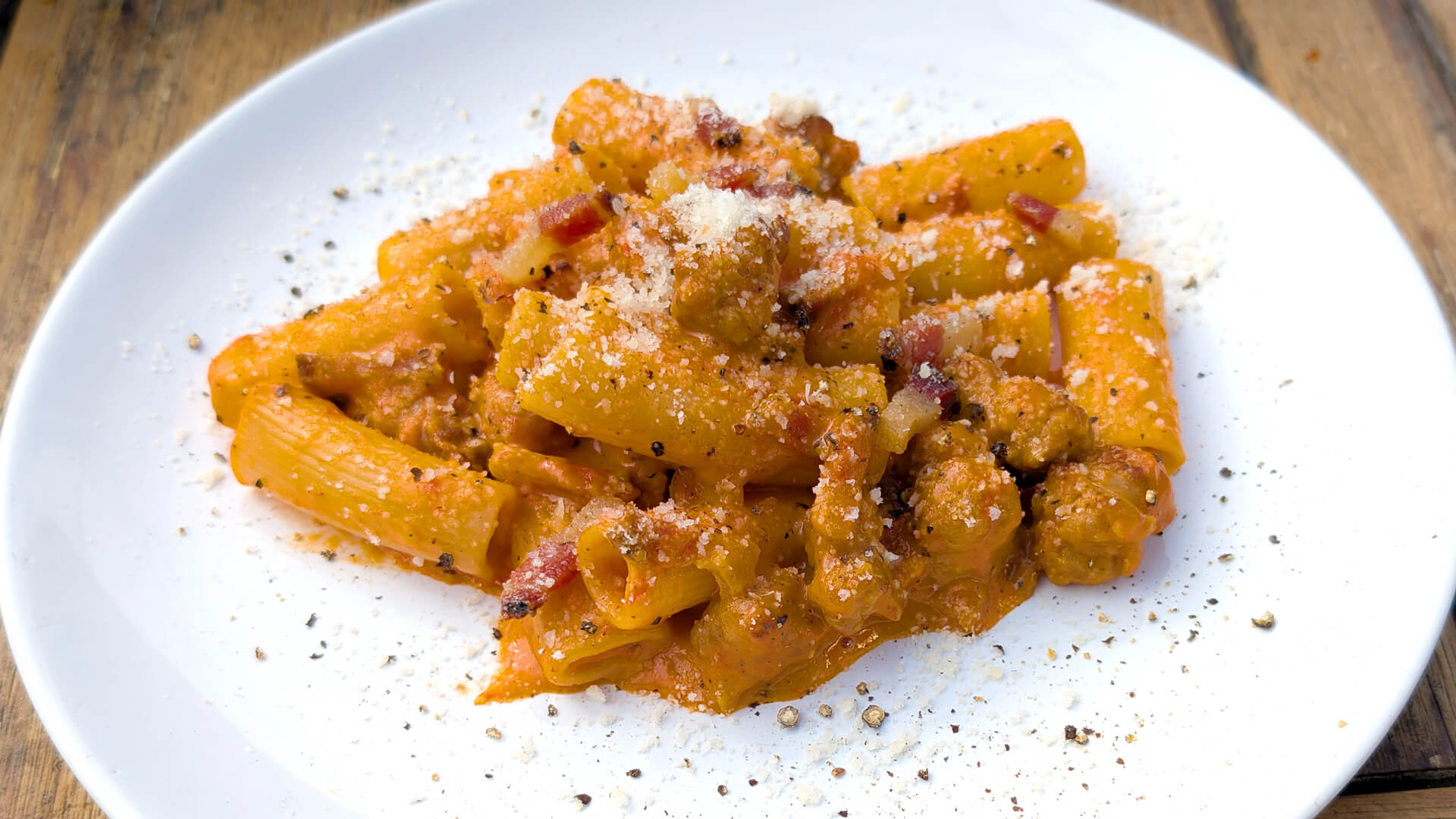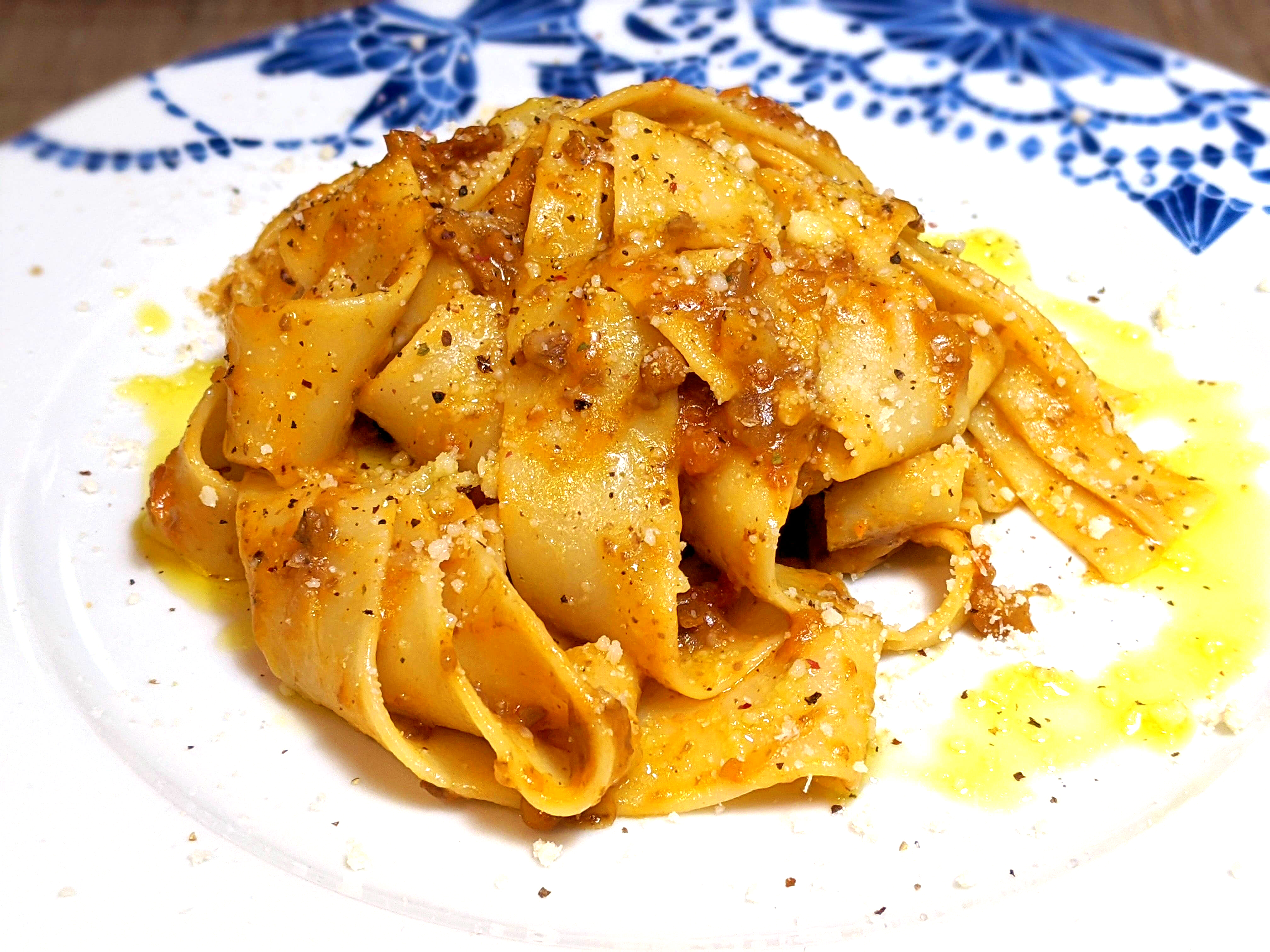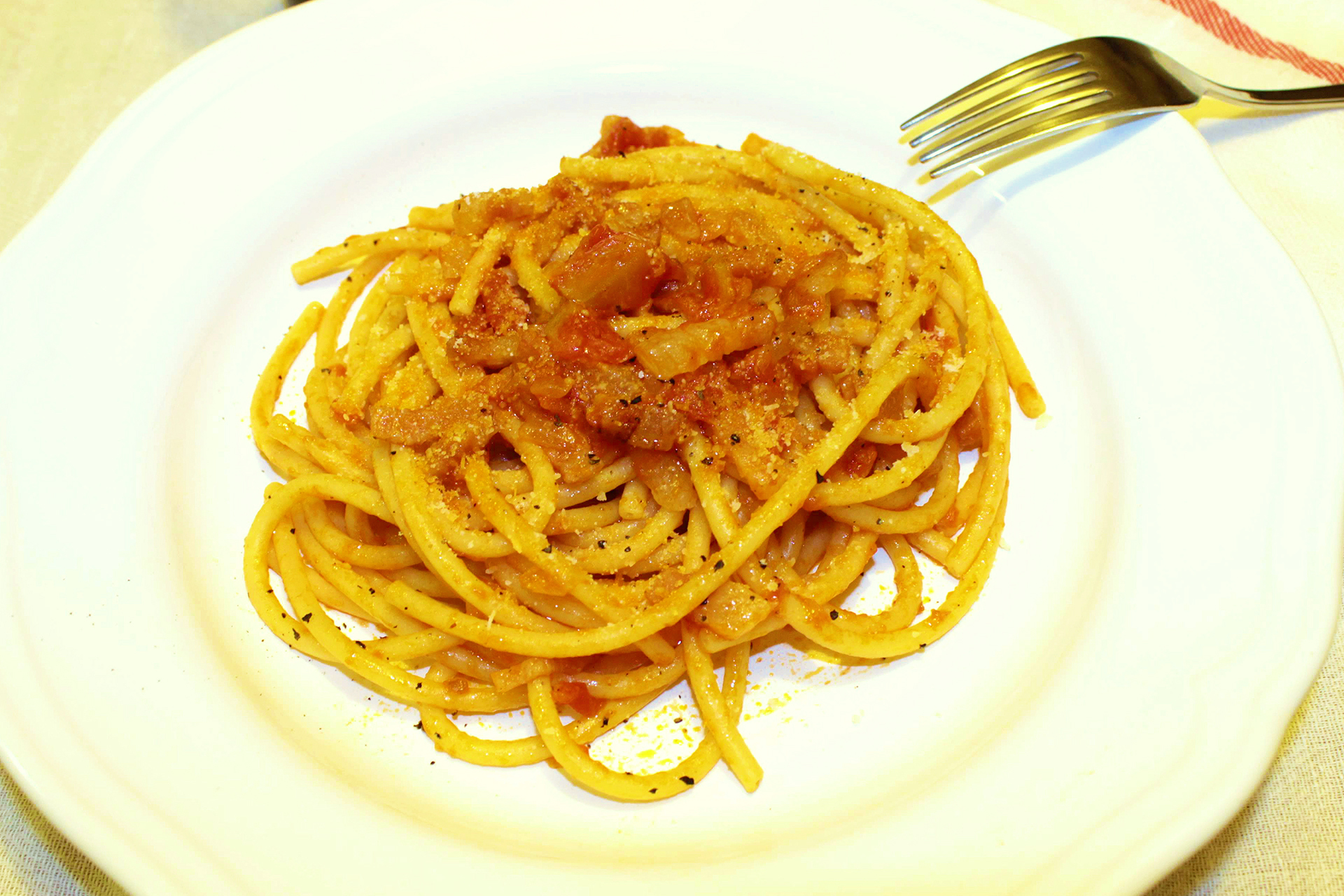Mamma mia! Today I’m going to tell you about an authentic gastronomic bomb: the famous pasta alla zozzona.
Imagine this: you’ve tried amatriciana with its tomato and guanciale, you’ve enjoyed the creaminess of a good carbonara, you’ve been seduced by the perfect simplicity of gricia, and you’ve fallen for the minimalism of cacio e pepe. Now… what would happen if we combined ALL these pleasures in a single dish?
A delicious “Frankenstein” of Roman cuisine
The zozzona is precisely that: a kind of filthy and delicious “Frankenstein” that combines all the elements that make Roman pastas great: crispy guanciale, sausage, creamy egg, tomato, and of course, the king of Rome, pecorino.
Its name couldn’t be more fitting – “zozzona” literally means “dirty” or “piggy” in Roman dialect. And it certainly lives up to its name! It’s an opulent, excessive, and absolutely wonderful dish.
From local secret to worldwide sensation
Interestingly, this culinary treasure, born in the picturesque Castelli Romani (that area south of Rome famous for its wines like Frascati), remained a local secret for a long time. It took the New York Times with its viral article for the whole world to set eyes on this marvel. Typical! Outsiders always have to come and discover our own treasures for us.
The perfect pasta for special occasions
It’s perfect for celebrations like carnival, when tradition invites us to enjoy without guilt before the austerity of Lent. It’s the last great gastronomic sin before “repentance,” the dish that all dietitians hate but your soul adores.
Do you dare to prepare this Roman delicacy at home? I promise you that after trying it, you may never see your rigatoni the same way again…
Additionally, I’ll explain step by step how to prepare pasta alla zozzona at home with all the tricks to make it perfect. Let’s go for it!
Index
Watch the video with all the steps
Below you can watch the video with all the steps of the recipe to prepare pasta alla zozzona in the easiest way. The video is in Spanish with English subtitles generated by Google. And if you haven’t done so yet, I invite you to subscribe to my YouTube channel so you don’t miss any new recipes. Don’t forget to follow me on Instagram! There I share more recipes, tips, and special content for Italian food lovers.

Main ingredients for pasta alla zozzona
For 2 servings
Preparation time: 10 min
Cooking time: 15 min (approx.)
- 180 g pasta (rigatoni or mezze maniche)
- 100 g guanciale
- 100 g fresh sausage
- 2 large egg yolks
- 200 g grated tomato
- 60 g grated Pecorino Romano or Grana Padano, if you prefer a milder taste
- Freshly ground black pepper (to taste)
Remember: At the end of the article you’ll find the complete recipe card with detailed cooking and preparation times.

How to prepare pasta alla zozzona
Preparation of ingredients
Before starting, put a large pot of water to boil for the pasta. Meanwhile, cut the guanciale into small cubes or strips and the sausage into small pieces. If you prefer, you can remove the skin from the sausage, although personally I like to leave it on so it maintains its shape better during cooking.
Browning the guanciale and sausage
In a large pan, cook the guanciale over medium-low heat without adding oil. We want it to release its own fat and get toasted on the outside while maintaining some tenderness inside. Once browned, remove it and set aside.
With some of the fat released by the guanciale (not all, to avoid making the dish excessively fatty), cook the sausage until it’s well browned on the outside.
Preparing the tomato sauce
Add the peeled tomatoes to the pan with the sausage. Crush them a bit and let them cook for about 5-7 minutes, until the tomato has reduced slightly. It’s important to taste as you go to adjust the salt, since both the guanciale and sausage tend to be quite salty.
When the sauce is ready, incorporate part of the reserved guanciale and mix well.
Preparing the egg and cheese mixture
In a bowl, mix the egg yolks with the grated pecorino and add a generous amount of freshly ground black pepper. Also add a bit of the guanciale fat to make the mixture creamier and easier to work with.
Cooking the pasta and combining all ingredients
When the water is boiling, add salt and cook the rigatoni al dente according to the package instructions. It’s better to leave them slightly firm as they will finish cooking with the sauce.
Drain the pasta, reserving some of the cooking water, and add it directly to the pan with the tomato and sausage sauce. Mix well so the pasta is impregnated with flavor.
Remove the pan from the heat and, with the residual heat, incorporate the egg and cheese mixture, stirring quickly so the egg doesn’t curdle and a cream is formed. If necessary, add some of the reserved cooking water to achieve the desired consistency.
Serving pasta alla zozzona
Serve immediately, adding the remaining crispy guanciale on top, a bit more grated pecorino, and an extra twist of black pepper.
Tips and tricks for perfect pasta alla zozzona
Control the fat
The guanciale and sausage release quite a bit of fat during cooking. To prevent the dish from becoming too heavy, remove part of this fat, keeping only what’s necessary to cook the rest of the ingredients.
Taste before salting
Both the guanciale and the sausage and pecorino are quite salty ingredients. Keep tasting during preparation to avoid making pasta alla zozzona too salty.
The secret is in the creaminess
To achieve the perfect creaminess when adding the egg and cheese mixture, it’s essential to remove the pan from the heat. The residual heat should be sufficient to thicken the sauce without curdling the egg.
Variations of pasta alla zozzona
If you prefer a sweeter and more balanced flavor, you can add a bit of onion to the initial sauté. Although traditional Roman recipes don’t usually include it, it adds an interesting touch that complements the rest of the flavors well.
When to prepare pasta alla zozzona
Pasta alla zozzona is perfect for special occasions like Carnival, when traditionally more opulent dishes are consumed before the austerity of Lent. However, you don’t need an excuse to enjoy this delicious pasta: any celebration or day when you want to give yourself a culinary treat is perfect to prepare it.
Due to its richness and heartiness, it pairs very well with wines from the Castelli Romani area, like a good Frascati, which help balance the intense flavors of the dish.
Frequently Asked Questions about pasta alla zozzona
Can I substitute pancetta for guanciale?
Although guanciale is traditionally used, if you can’t find it you can substitute pancetta. The flavor will be slightly different, but it will still be delicious. The important thing is that it’s pancetta with a good amount of fat to add flavor to pasta alla zozzona.
What type of sausage is best for pasta alla zozzona?
Ideally, use a fresh Italian sausage, preferably not too spicy so it doesn’t mask the other flavors. If you can’t find Italian sausage, you can use good quality fresh pork sausage.
Can I use long pasta instead of rigatoni?
Although pasta alla zozzona is traditionally prepared with rigatoni, you can use other pastas like spaghetti if you prefer. The advantage of rigatoni is that their hollows trap the sauce and pieces of guanciale and sausage very well.
What’s the secret to keeping the egg sauce from breaking?
The key is to remove the pan from the heat before adding the egg mixture. The residual heat should be sufficient to thicken the sauce without curdling the egg. Adding a bit of the pasta cooking water, rich in starch, also helps emulsify the sauce of pasta alla zozzona.
Can pasta alla zozzona be prepared in advance?
Pasta alla zozzona, like most pastas, is best when freshly made. The creamy sauce tends to thicken and lose its perfect texture when cooled. If you need to prepare it in advance, I recommend having all the components ready and doing the final assembly at the last moment.
Related recipes you’ll love
If you liked pasta alla zozzona, you’ll surely enjoy these other traditional Roman pastas:
- Pasta Cacio e Pepe: the simplest recipe yet full of flavor, with pecorino romano and black pepper.
- Pasta Amatriciana: with guanciale, tomato, and pecorino, a classic of Roman cuisine.
- Pasta Carbonara: authentic Italian carbonara, creamy and without cream.
- Pasta Gricia: considered the “white carbonara,” a delight with guanciale and pecorino.
Enjoy your pasta alla zozzona and surprise everyone!
This recipe is proof that sometimes the boldest combination is the most delicious. Pasta alla zozzona brings together the best of each Roman pasta in a single dish that will transport you directly to the Castelli Romani.
Feel encouraged to prepare pasta alla zozzona at home and tell me in the comments how it turned out. If you liked this recipe, subscribe to my YouTube channel and Instagram to discover more authentic Italian dishes. Leave a comment with your impressions and share your photos on social media. I’d love to see your creations!
Buon appetito!
The latest video recipes from my channel!
The card
Pasta alla Zozzona: The Roman recipe combining Amatriciana, Carbonara & Gricia
Ingredients
- 180 g rigatoni or mezze maniche pasta
- 100 g guanciale
- 100 g fresh sausage
- 2 large egg yolks
- 200 g grated tomato
- 60 g grated Pecorino Romano or Grana Padano
- Freshly ground black pepper to taste
- Salt
Instructions
- Bring a large pot of water with salt to a boil for the pasta.
- Cut the guanciale into small cubes or strips and the sausage into small pieces (you can remove the sausage skin if you prefer).
- Brown the guanciale and the sausage: In a large pan, cook the guanciale over medium-low heat without adding oil, so that it releases its own fat. Once browned, remove it and set it aside.
- With a little of the guanciale fat (without overdoing it), cook the sausage until it is nicely browned.
- Prepare the tomato sauce: Add the peeled tomato (slightly crushed) to the pan with the sausage.
- Cook for 5–7 minutes until the tomato reduces slightly, tasting and adjusting the salt as needed.
- Incorporate part of the reserved guanciale and mix well.
- Egg and cheese mixture: In a bowl, mix the 2 egg yolks with the grated cheese (Pecorino Romano or Grana Padano) and add plenty of freshly ground black pepper.
- Add a little of the guanciale fat to obtain a creamier mixture.
- Cook the pasta until al dente in the boiling water.
- Drain the pasta, reserving some of the cooking water, and add it directly to the pan with the tomato and sausage sauce.
- Mix well so that the pasta absorbs the flavor.
- Finalize the sauce: Remove the pan from the heat and, using the residual warmth, incorporate the egg and cheese mixture, stirring quickly to prevent the egg from scrambling.
- If necessary, add a little of the reserved cooking water to achieve the desired consistency.
- Serve immediately, garnishing with the remaining crispy guanciale, a little extra grated cheese, and an additional touch of black pepper.
Video
Notes
- Control the fat: Remove some of the fat from the guanciale and sausage if the dish turns out too heavy.
- Taste before salting: The ingredients already contribute salt, so adjust carefully.
- The secret to creaminess: Remove the pan from the heat before adding the egg mixture to avoid curdling.






